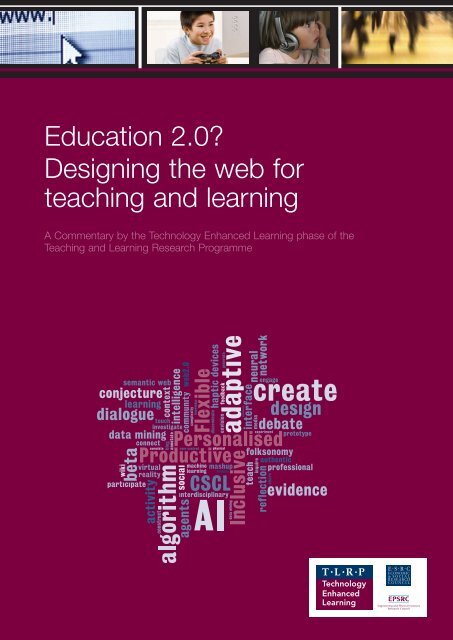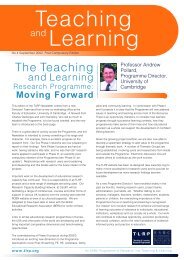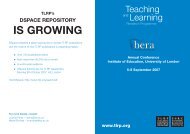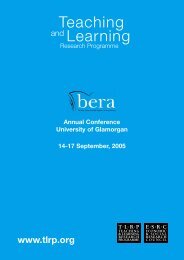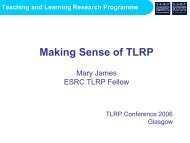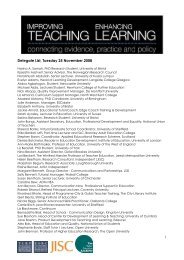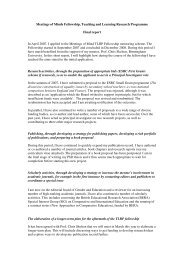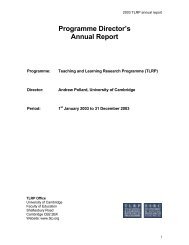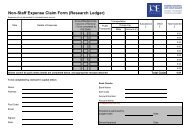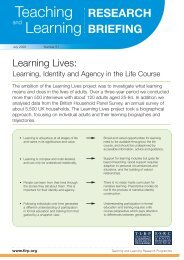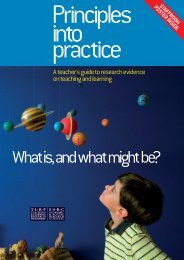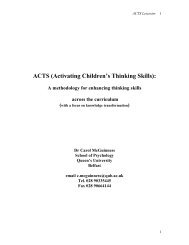Education 2.0? - Teaching and Learning Research Programme
Education 2.0? - Teaching and Learning Research Programme
Education 2.0? - Teaching and Learning Research Programme
- No tags were found...
You also want an ePaper? Increase the reach of your titles
YUMPU automatically turns print PDFs into web optimized ePapers that Google loves.
IntroductionNeil SelwynThe past five years or so have seen growing excitement within the educational community about web<strong>2.0</strong> technologies. ‘Web <strong>2.0</strong>’ is an umbrella term for a host of recent internet applications such as socialnetworking, wikis, folksonomies, virtual societies, blogging, multiplayer online gaming <strong>and</strong> ‘mash-ups’.Whilst differing in form <strong>and</strong> function, all these applications share a common characteristic of supportinginternet-based interaction between <strong>and</strong> within groups, which is why the term ‘social software’ is oftenused to describe web <strong>2.0</strong> tools <strong>and</strong> services.Web <strong>2.0</strong> marks a distinct break from the internet applications of the 1990s <strong>and</strong> early 2000s, facilitating‘interactive’ rather than ‘broadcast’ forms of exchange, in which information is shared ‘many-to-many’rather than being transmitted from one to many. Web <strong>2.0</strong> applications are built around the appropriation<strong>and</strong> sharing of content amongst communities of users, resulting in various forms of user-drivencommunication, collaboration <strong>and</strong> content creation <strong>and</strong> recreation. Commentators now talk of a ‘read/write’ web, where users can easily generate their own content as well as consuming content produced byothers. 1For example, Wikipedia is distinct from the Encyclopaedia Britannica Online because it is an opendocument that is created, updated, edited <strong>and</strong> refereed by its readers, thus deriving accuracy <strong>and</strong>authority from ongoing group discussion <strong>and</strong> consensus rather than the word of one expert. Similarly,Flickr could be considered as distinct from earlier online applications such as Ofoto in that users’photographs are made accessible to all <strong>and</strong> can be commented upon, labelled, categorised <strong>and</strong> edited bywhole communities of users, making it a photograph-sharing rather than photograph-storage application.Given the importance of creation, collaboration <strong>and</strong> communication to the use of these technologies,educationalists have been quick to point out the potential of web <strong>2.0</strong> for supporting <strong>and</strong> enhancinglearning. Yet despite valuable early contributions to the web <strong>2.0</strong> debate from, for example, JISC <strong>and</strong>Futurelab, 2 much of the discussion within the education community has been speculative.This Commentary sets out to challenge the confident portrayal of web <strong>2.0</strong> by many educationalists interms of an imminent transformation of learning <strong>and</strong> teaching. Careful thought has therefore been given tohow technologists, educators <strong>and</strong> learners can best shape the fast-changing internet in the near future. Itaims to explore how education can change the web, as well as how the web can change education.
<strong>Education</strong> <strong>2.0</strong>?A focus on the virtualisation of trading relations highlights a change in the location of exchanges, from the bricks<strong>and</strong> mortar contexts of real world trade to the electronic traffic of virtual world trade. Such virtualisation reducesoverheads <strong>and</strong> drives down commodity prices. Many web <strong>2.0</strong> services have no charge at all. Their revenuecomes from alternative ‘premium’ versions of the service or from advertising. This in turn motivates more userengagement. However, when the commodities are themselves in digital format (downloadable files ratherthan shipped CDs, for example), then a second consequence of virtualisation is the user expectation that thecommodities they purchase will be upgradeable. This has encouraged a fluid <strong>and</strong> iterative approach to productdesign <strong>and</strong> to internet services more generally. It is captured in the fashionable web <strong>2.0</strong> phrase ‘perpetualbeta’. In development talk, the ‘beta’ stage of design is where a product is released while understood to bestill only approaching complete <strong>and</strong> stable form. The ease with which digital products can be upgraded hasencouraged a perpetual beta attitude towards design, where products <strong>and</strong> practices are inherently evolving,rather than comfortably finished.A final consequence of virtualisation is its ‘levelling effect’. What gets levelled in the virtual world is the cost ofproduct availability <strong>and</strong> also the cost of participating as a vendor in the various market places of exchange.It is no more expensive to store <strong>and</strong> advertise a copy of J.R. Hartley’s obscure book Fly Fishing than it isJeffrey Archer’s latest blockbuster. More importantly, the low overheads of an internet presence will level theopportunities for marketplace participation, whether in selling books, providing services, or authoring opinions.It follows that a virtual consumer can locate Fly Fishing just as easily as they can find all of Jeffrey Archer’swritten work. Such levelling is more challenging when the product is news, commentary, or scholarship, <strong>and</strong>it certainly implies emancipation, empowerment, <strong>and</strong> participation. But that in turn must also imply searching,selecting, <strong>and</strong> filtering. In adopting web <strong>2.0</strong>, education will have to confront the challenge of cultivating learnerdiscernment as well as that of stimulating learner participation.Key web <strong>2.0</strong> servicesThe activities most often associated with web <strong>2.0</strong> realise four typically human dispositions: the playful, theexpressive, the reflective <strong>and</strong> the exploratory.iSocialising the playful: games <strong>and</strong> virtual worldsThe socialisation of computer gaming lifts it from a typically private challenge into a competitive or collaborativemulti-user one. A web <strong>2.0</strong> game is one that allows geographically distributed users to take part in a structuredexchange. The themes are often the traditional warring formats, although educational formats are alsopossible 3 <strong>and</strong> will doubtless evolve. However, the most high profile <strong>and</strong> promising examples are the virtualworlds, such as Second Life 4 . Enthusiasts will stress that these are not simply another sort of gaming, butanother sort of living. The user acquires a screen persona (an ‘avatar’) that can move fluently in <strong>and</strong> out ofcustom-designed environments for interaction <strong>and</strong> display. Concerts, meetings, relationships <strong>and</strong> educationalpractices can all be managed in such spaces. Despite the apparent depth of participation that such virtualworld systems allow, their impact remains modest compared with other web <strong>2.0</strong> activities. This may reflect thecumbersome processes involved in even simple acts of communication <strong>and</strong> sharing, or the lack of a criticalnumber of active users, a crucial matter for the evolution of a web <strong>2.0</strong> service.7
ii Socialising the expressive: media design, sharing, <strong>and</strong> publicationThe capacity for trading <strong>and</strong> sharing media files, notably music downloads, has stimulated growth in theamateur production of such material. A number of tools have appeared to meet this interest. To some extentthese mirror traditional tools for manipulating digital media, providing ways of splicing, editing, dubbing <strong>and</strong>so forth. Other tools encourage the mixing of ready-made items taken, as it were, from the shelf. 5 The livelypractice of the ‘web mash-up’ celebrates the potential of taking existing media items <strong>and</strong> ‘mashing’ themtogether to make a new product, typically accessible through a web browser. Expressive activity with digitalmaterial has become a realistic ambition for users, <strong>and</strong> the activity has been socialised through the growthof internet outlets that permit sharing, publication or broadcasting. These sites allow the posting of usergeneratedcontent, most famously in silos for video, photographs, sketches, <strong>and</strong> slideshows. 6iii Socialising the reflective: blogs, social networks, <strong>and</strong> wikisTraditional outlets for personal reflection include the diary <strong>and</strong> the notebook. Such resources have beensocialised by web <strong>2.0</strong> technologies in a variety of formats. Perhaps the best known is the ‘blog,’ a web-basedlog or journal in which an author’s postings (text, sound, images, video, or weblinks) become visible onlineto others who can engage with them by posting comments in response to the author’s entries. The socialnetworking sites, famously Facebook <strong>and</strong> MySpace, can be seen as elaborations of this format into moretightly-knit <strong>and</strong> manageable communities of reflective users. On these sites, registered users can specifythe ‘friends’ who can access their blog-like web space. They can develop personal identity <strong>and</strong> cultivaterelationships by posting <strong>and</strong> exchanging digital material, playing online games, <strong>and</strong> joining groups that sharecommon interests. The blog tradition is personal <strong>and</strong> diary-like. The wiki shares a quality of ‘perpetual beta’with the blog but it allows other users an equable right to edit <strong>and</strong> develop content in a common space. Thusit is well-suited to the collaborative building of specialist knowledge. The best-known version of this idea isWikipedia. 7iv Socialising the exploratory: syndication, recommenders, folksonomiesThe searching <strong>and</strong> filtering that comprise an individual’s exploratory activity has also been socialised by web<strong>2.0</strong> technologies. The increasingly participatory nature of the web challenges the user to keep abreast of everemergingnew material. Syndication involves some portion of a website being made available to users by theirsubscribing to a ‘feed’ that automatically delivers requested material <strong>and</strong> updates to their browser or somedesktop ‘aggregator’ application. The most prominent example is the podcast, whereby a user may subscribeto or publish a regularly-released digital media file, such as a radio broadcast. Portals exist to help tracethese podcasts. 8 However, exploration also involves discovery. Web <strong>2.0</strong> socialises this by integrating data onselections that users make online. Internet book traders such as Amazon.com will capture the titles that theirindividual users browse. When a user selects a title, the trader can trace the selections of other users who havebrowsed that title <strong>and</strong> make them visible, thereby creating recommendations. Such coordination of user choicescan also be applied to a user’s personal music files, or to their web browser bookmarks if they are willing tomake them visible to the integrating service.A development of this anonymous sharing arises when users are encouraged to tag internet material that theycreate or find, particularly web-based articles, images, or videos. This activity generates a ‘tag cloud’ that maybe centred on an individual, <strong>and</strong> thereby express their interests, or on other internet items such as a page,a picture, or a published article, <strong>and</strong> thereby express its content or concerns. The form of categorising thatemerges from such activity has become known as a ‘folksonomy’ – distinguishing it from the more formal <strong>and</strong>ordered traditions of ‘taxonomy’. There are a wide variety of tools that help users identify <strong>and</strong> navigate suchdescriptive systems.
<strong>Education</strong> <strong>2.0</strong>?<strong>Learning</strong> concepts behind web <strong>2.0</strong>Any educational practice that concerns the playful, expressive, reflective or exploratory aspects of knowledgebuilding is likely to find web <strong>2.0</strong> tools <strong>and</strong> services a powerful resource. Moreover, educators can safely assumethat most learners know about them. When directed at learning, web <strong>2.0</strong> impacts on four principal dimensionsof the learner’s experience. Two are broadly social in nature (collaboration <strong>and</strong> publication) <strong>and</strong> two are morecognitive (literacies <strong>and</strong> inquiry).i) Collaboration Web <strong>2.0</strong> services support communication. They allow learners to coordinate their activitiesto various degrees of depth. This can range from the relatively trivial level of participating in anonymousrecommender systems to the more intense level of interpersonal, verbal debate. Web <strong>2.0</strong> may offer educatorsa set of tools to support forms of learning that can be more strongly collaborative <strong>and</strong> more oriented to thebuilding of classroom communities.ii) Publication We expect to see the work of learners on display in a classroom. The read-<strong>and</strong>-write characterof web <strong>2.0</strong> supports users in creating original material for publication. Its relatively unbounded space can offer astrong feeling of doing authentic research when students can publish <strong>and</strong> discuss the products of their study.iii) Literacies Culture stimulates a form of intelligence that is ‘literate’. Schooling cultivates a distinctorientation towards language, to which interactions with writing are crucial. Digital media stretch this tradition byoffering new modes of representation <strong>and</strong> expression. Even the term ‘literacy’ now has to be stretched to admitother forms of representational fluency than those associated with the printed word. As learners engage withdigital artefacts through web <strong>2.0</strong>, so the curriculum must address the challenge of developing their confidencewith new literacies <strong>and</strong> their increased potential for creativity.iv) Inquiry Web <strong>2.0</strong> technologies offer new ways for learners to conduct personal research. It creates newstructures for organising data, new sources to refer to, new forms of authority, <strong>and</strong> new tools to interrogate thisrich space of information. All of this has the potential to empower the student as an independent learner. But italso brings challenges to both learner <strong>and</strong> teacher. Web <strong>2.0</strong> knowledge structures are not navigated with thesame tools or the same ease as more traditional documentary collections. It poses problems of authority <strong>and</strong>the ephemeral nature of web ‘knowledge’.Web <strong>2.0</strong> tools appear to strengthen fundamental aspects of learning that may be difficult to stimulate inlearners. There are problems with web <strong>2.0</strong> learning in practice, but these tools do seem to mark a step changein the ways in which learners can interact with <strong>and</strong> on the web. Alongside business, journalism <strong>and</strong> medicine, itis therefore perhaps not too fanciful to talk of ‘education <strong>2.0</strong>’.9
<strong>Education</strong>al hopes <strong>and</strong> fears for web <strong>2.0</strong>Neil Selwyn<strong>Education</strong>al responses to web <strong>2.0</strong>The evolving nature of web <strong>2.0</strong> makes it a ready vehicle for a number of educational agendas. We shouldremain cautious of some of the more exaggerated claims currently surrounding web <strong>2.0</strong>. Both ‘booster’<strong>and</strong> ‘doomster’ discourses have grown up around web <strong>2.0</strong>, portraying its possible educational ‘effects’ <strong>and</strong>‘impacts’ in decidedly overstated terms. 1 At one extreme are enthusiastic hopes for a complete transformationof education systems, with some commentators extending the technology terminology of ‘<strong>2.0</strong>’ through talk of a‘re-booting’ of teaching <strong>and</strong> learning. At the other, some commentators have used web <strong>2.0</strong> to generate moralpanics about young people <strong>and</strong> the supposed death of education.Web <strong>2.0</strong> <strong>and</strong> new forms of learningThere are strong links between web <strong>2.0</strong> <strong>and</strong> socio-cultural theories of learning, which see active <strong>and</strong> authenticlearning taking place best where knowledge can be constructed actively by learners who are supported incommunal social settings. It follows that web <strong>2.0</strong> tools may offer learners a more participatory experience oflearning in which individuals have increased opportunities to interact with more learners <strong>and</strong> with more learningresources.Much of the learning potential of web <strong>2.0</strong> is seen to derive from the co-construction of knowledge. Aconstructivist ethos lies at the centre of practices such as folksonomies, mash-ups <strong>and</strong> wikis, as well as being acentral tenet of popular web <strong>2.0</strong> philosophies such as ‘Smart Mobs’, ‘We Think’ <strong>and</strong> the ‘Wisdom of Crowds’. 2Notions of constructivism <strong>and</strong> constructionism inform recent celebration of the participative learning cultures ofvirtual societies <strong>and</strong> multi-player online games. 3 Similarly, the ability to collaboratively edit as well as individuallyread resources such as Wikipedia is seen to lead individuals to learn “what works <strong>and</strong> what does not in away that was not possible with books. You wouldn’t have even joined the debate”. 4 The collaborative spiritof these web <strong>2.0</strong> activities <strong>and</strong> many others like them has coalesced into a prevailing sense that “the internethas created greater opportunities for access, debate <strong>and</strong> transparency in the pursuit of knowledge than everbefore”. 4Web <strong>2.0</strong> <strong>and</strong> new forms of learnersWeb <strong>2.0</strong> technologies are also associated with significant shifts in the nature of contemporary learners. Apopular characterisation of upcoming generations of learners is that they are ‘digital natives,’ who have grownup in a world of computers, mobile telephony <strong>and</strong> the internet, <strong>and</strong> now lead lives that are reliant upon digitalmedia. These digital natives are seen to st<strong>and</strong> in stark contrast to older generations of ‘digital immigrants’ whoadopted digital media later on in their lives, having grown up without them. Commentators talk of young peopleas ‘homo-zappiens’, ‘net savvy’ <strong>and</strong> ‘power users’. Some commentators talk of the ‘internet generation’,‘generation M’ (media), ‘generation V’ (virtual) or ‘generation C,’ referring to characteristics such as connected,creative <strong>and</strong> click. 5 Their digitally-mediated everyday lives are characterised by constant change, withtechnology lying at the heart of mobile, reflexive, ‘liquid’ lifestyles. 6 These digital natives are thought to expecttechnology-assisted fluidity in all aspects of their lives, including the ways in which they learn <strong>and</strong> are educated.They are thought to have distinct expectations of education that involve learning which is personalised,accessible on-dem<strong>and</strong>, <strong>and</strong> available at any time, any place, or any pace. As Marc Prensky warned at the turnof the century, “our students have changed radically. Today’s students are no longer the people our educationalsystem was designed to teach”. 7
Other commentators point towards the contribution of web <strong>2.0</strong> to “the development of a culture of disrespect”between learners <strong>and</strong> formal education providers. 15 There have been recent high-profile instances of school <strong>and</strong>university students being sanctioned for distributing inappropriate comments about their peers <strong>and</strong> teachers<strong>and</strong>, in a few instances, hastening the dismissal of unpopular teaching staff through web <strong>2.0</strong>-based campaigns.Concerns have been raised over the realignment of power within the learner/teacher relationship that web <strong>2.0</strong>technologies appear to foster. For example, this is apparent in websites such as Ratemyprofessors.com orstudents posting c<strong>and</strong>id video excerpts of their teachers on content-sharing sites such as YouTube. Whilstsome commentators welcome the empowering nature of these technology practices, others in the educationestablishment portray it in negative terms - what a past UK education minister termed “the sinister downside ofmodern technology”. 16The need for an empirical perspective on web <strong>2.0</strong> <strong>and</strong> learningAs these examples suggest, web <strong>2.0</strong> is currently the focus of a number of long-running educational debates<strong>and</strong> controversies - not least over the devaluing of state-run education, the erosion of public values <strong>and</strong> thecontinued viability of schooling. Web <strong>2.0</strong> therefore leaves education technologists facing new variations onsome age-old questions, especially whether the rise to prominence of these technologies can recast education<strong>and</strong> learning in more dynamic, desirable <strong>and</strong> democratic terms, or else is set to hasten the dumbing-down ofeducation <strong>and</strong> turning-off of learners.
<strong>Education</strong> <strong>2.0</strong>?<strong>Learning</strong> <strong>and</strong> virtual worldsDiane CarrVirtual worldsThe term virtual world refers to a computer-based environment, <strong>and</strong> encompasses online games such as Worldof Warcraft as well as social worlds such as Second Life. Virtual worlds play host to collaboration, creativeproduction <strong>and</strong> dissemination, socialising, role-play, programming <strong>and</strong> building. There are significant differencesbetween online multiplayer computer games <strong>and</strong> social worlds, but educators are interested in the two forsimilar reasons, including their capacity to immerse <strong>and</strong> motivate learners, <strong>and</strong> the potential to alter a user’srelationship to technology. 1Games generally involve rules <strong>and</strong> goals. Yet multiplayer games are not predetermined, rule-bound experiences.Recent qualitative <strong>and</strong> quantitative research has helped to reveal the complexity of online game worlds. 2 Play inpopular MMORPGs (Massively Multiplayer Online Role Playing Games) emerges across an elective spectrum.Games such as World of Warcraft do accommodate virtual combat <strong>and</strong> overt goals, but they also support thepleasures associated with exploration, chat, experimentation, improvisation, humour <strong>and</strong> role-playing. Onlinegaming involves playing within parameters (provided by rules or virtual physics, for example) but it also involvesplaying with these constraints. From trading, dancing <strong>and</strong> consensual duelling, to player-versus-player ambush,online games come to life through the actions <strong>and</strong> prerogatives of participants. Even combative, goal-orientedplay involves players providing social support in the form of ‘clans’ <strong>and</strong> ‘guilds’, collaboration <strong>and</strong> mentoring.<strong>Learning</strong> is central to playing an online game. But those with an interest in teaching are more likely to be drawnto social worlds such as Second Life. What Second Life offers that the current alternatives do not is a relativelystable <strong>and</strong> accessible, inexpensive <strong>and</strong> inhabited, persistent world where it is possible to build simulations ofprocesses (biological or geological, for instance), as well as locations such as a cinema, a habitat or a campus.To begin to explore Second Life it is necessary to design an ‘avatar’ - a personification in the virtual world.This avatar is named, but its gender <strong>and</strong> species can be switched. It might change from an elderly librarian toa rabbit or a robot. While in Second Life I might choose to explore, or I can focus instead on learning to makeh<strong>and</strong>bags, scooters, horses or houses. I can write or buy scripts (programming) that will enable my avatar toperform simple animations, <strong>and</strong> thus exp<strong>and</strong> its (<strong>and</strong> hence my) expressive repertoire. In the guise of my avatarI can run a business <strong>and</strong> meet other ‘people’ at conferences, in nightclubs or at gallery openings. I might act infilms that are shot in-world (known as ‘machinima’) or collaborate in the construction of a neighbourhood.As this list of possible activities suggests, there is one Second Life, but many ‘second lives’. Second Life is atoolset, a virtual world, <strong>and</strong> it supports social networks. It is not a game, but it is a platform for play, <strong>and</strong> a placewhere people might gather to build or play games. While users might not be confronted with a set of gamerules, there are constraints in place, including the developer’s Terms of Service, as well as community etiquette.While there might not be a specified mission or goal, there are goal-oriented practices <strong>and</strong> values includingsocial approbation <strong>and</strong> reputation.Some educators planning sessions in a virtual world such as Second Life focus on technical aspects (runningclasses on scripting, for example), or building <strong>and</strong> testing simulations. Others might exploit its creative or socialaspects, or use Second Life to teach specific content (geology or geography, for instance) through discussion,demonstration or practical exercises. Other teachers <strong>and</strong> students might see Second Life itself as a cultural ortechnical phenomenon deserving of study. Some might simply regard the virtual world as a convenient locationfor a class meeting.13
<strong>Education</strong> <strong>2.0</strong>?iMaking ‘Sloodle’‘Sloodle’ is an open-source project affiliated with the University of the West of Scotl<strong>and</strong> that is designed tocombine the offers of Second Life (avatars, interactivity <strong>and</strong> 3D rendering) with those of Moodle, a ‘learningmanagement system’, while addressing the perceived limitations of both. 6 The resulting hybrid offers educatorsobjects <strong>and</strong> documents that can be moved between an explorable 3D virtual environment <strong>and</strong> ‘the Moodleclassroom’. 7 As David Livingstone, one of the developers, argues, such tools can enhance teaching <strong>and</strong>learning in higher education settings. He notes that social <strong>and</strong> contextual issues, such as a student’s existingexpertise <strong>and</strong> expectations, are likely to impact on that participant’s assessment of a session:“I’ve had quite varied reactions from students. My intake is usually a mix of Game Technology, ComputerAnimation, <strong>and</strong> Multimedia students. Students who are already experienced 3D animators or modellersinvariably find the modelling tools in Second Life incredibly bizarre <strong>and</strong> awkward - <strong>and</strong> often struggle more thanstudents with no prior 3D modelling experience. Technically minded students in a taught lecture <strong>and</strong> lab basedclass (on campus) may not see the point of Second Life - they want to do ‘real programming’ rather than ‘playabout in a toy world’. A minority discover the scripting language early on <strong>and</strong> like to play with it to see what theycan do with it […] Multimedia or web-development students often have more general skill sets, <strong>and</strong> also seemless likely to have the negative reactions”. 8ii Ethnographic research training in Second LifeIn a recent article ‘<strong>Learning</strong> to <strong>Research</strong> in Second Life: 3D MUVEs as meta-research fields’, educators workingat the Universidade do Vale do Rio do Sinos in Brazil have reported on their use of Second Life as a field for‘apprentice ethnographers’. Second Life allowed their students to conduct fieldwork independently <strong>and</strong> indifferent virtual locations, while having access the tutor via instant messaging for real-time support. The authorsfound that:“the strategy of providing the students with complete freedom of action within Second Life, but remainingat their disposal to clarify doubts <strong>and</strong> provide support when required, resulted in a team of apprenticeethnographers that were both seriously engaged with the activity <strong>and</strong> sufficiently secure to be able toexperiment <strong>and</strong> improvise”. 9But there are disadvantages to Second Life as an educational setting, including problems relating to hardware,time lags due to varying internet connectivity, <strong>and</strong> difficulties relating to class control <strong>and</strong> the formalising oflessons.iii <strong>Teaching</strong> research methods in Second Life<strong>Research</strong>ers at the London Knowledge Lab have taught classes in Second Life on various topics, includinginternet research ethics <strong>and</strong> virtual world research. 10 Distance learners were found to be very positive about thereal-time, social aspects of the sessions. The facilitators also found that the obviously constructed nature ofSecond Life rendered session design visible to students, who proceeded to question <strong>and</strong> reflect on teachingpractices. The move to a virtual world was found to upset some participants’ preconceptions of onlinepopulations, as well as their assumptions about the relationship between a ‘researcher’ <strong>and</strong> the ‘researched’.These kinds of ambiguities <strong>and</strong> disruptions can be highly productive. However, judging any affective aspectsof the student experience in real time in Second Life can be difficult. A motionless avatar could mean a studentis avidly following a rapid discussion, or that they are confused <strong>and</strong> alienated. Or that the student has goneto make coffee. Second Life sessions can be intense <strong>and</strong> potentially confusing experiences for participantswho are unfamiliar with online worlds. Some students may struggle with the interface or with communications,whether by text or voice. Students who have played online games may be disappointed by the graphics <strong>and</strong> therelative emptiness of Second Life. While virtual worlds may invite experimental pedagogy, students’ familiaritywith the interface <strong>and</strong> in-world social practices still need to be considered, as do their expectations of whatconstitutes learning <strong>and</strong> teaching.15
Virtual worlds <strong>and</strong> learning - key messages from the researchEducators are showing fervent interest in virtual worlds. Reports <strong>and</strong> papers are becoming available, butin-depth, peer-reviewed studies of learning <strong>and</strong> pedagogy in virtual worlds are still rare. The sheer range ofdisciplinary perspectives (from the computer sciences to the visual arts) <strong>and</strong> variety of teaching <strong>and</strong> learningcontexts (from adults to children, from formal to informal) make it difficult to draw general conclusions or toencapsulate findings.Reports <strong>and</strong> papers are becoming available, but in-depth, peer-reviewed studies of learning <strong>and</strong> pedagogyin virtual worlds are still rare. The sheer range of disciplinary perspectives (from the computer sciences to thevisual arts) <strong>and</strong> variety of teaching <strong>and</strong> learning contexts (from adults to children, from formal to informal) makeit difficult to draw general conclusions or to encapsulate findings.For educators, the existing literature on pedagogy <strong>and</strong> social learning, playful learning, drama, simulations,practical experimentation <strong>and</strong> communities of practice has clear relevance to virtual worlds. Virtual worlds alsopresent educators with an opportunity to revisit questions of ‘presence’ or ‘immersion’ <strong>and</strong> thus make referenceto older ‘virtual reality’ studies. <strong>Research</strong>ers appreciate that existing literature might be relevant, yet alsorecognise that these concepts <strong>and</strong> theories might themselves be challenged or altered when applied to virtualworlds. It is already possible to point to gaps in the literature <strong>and</strong> suggest areas for future research. Theseinclude:• pedagogy <strong>and</strong> curricular design;• social learning;• the emergence of viable alternatives to Second Life;• equality <strong>and</strong> access (in relation to disability or broadb<strong>and</strong>, for example;• institutional policyFurther work on theories of immersion, presence, identification, agency, role <strong>and</strong> affect could also enrichresearch in this area.When researching or seeking to use virtual worlds as educational tools, it is important to acknowledge theirambiguity <strong>and</strong> variability. But this ambiguity is not a problem to be designed out. It allows virtual worldsto ‘render strange’ the conventions that underlie teaching including teacher <strong>and</strong> student roles, classroomlayout <strong>and</strong> assessment practices. Virtual worlds have the potential to trouble the roles of teacher, learner <strong>and</strong>researcher in productive ways. These offers - in addition to their more obvious social, technical <strong>and</strong> creativepotentials - are why educators are right to be interested in virtual worlds.
<strong>Education</strong> <strong>2.0</strong>?Inter-Life: Interoperability <strong>and</strong> Transition is a TLRP-Technology Enhanced <strong>Learning</strong> project based atthe University of Glasgow, with partners at the Universities of Stirling, Sheffield <strong>and</strong> Edgehill. The projectstarted in November, 2008.It is developing a mobile 3D virtual community in which participants can work together on activities fromtheir own computer or via a mobile device. The key investigations will focus on young people’s skillsdevelopment to enhance their management of life transitions. Key themes for investigation are:• User engagement, co-design, <strong>and</strong> developmentUsers are centrally placed in the design of Inter-Life so that the development of the learning communityengages them fully in project activities. Users can make changes to the project activities <strong>and</strong> 3D spaceto reflect their needs <strong>and</strong> ideas as they develop transition skills. This dynamics of this centrality is a keyaspect of the investigation.• Identification of learning outcomes, processes, <strong>and</strong> skills acquisitionOne of the project’s central aims is to underst<strong>and</strong> how participation in a 3D mobile-enhancedcommunity supports learning processes <strong>and</strong> outcomes, on both individual <strong>and</strong> group-based tasks <strong>and</strong>projects. An underst<strong>and</strong>ing of the role that 3D communities can play in social <strong>and</strong> cognitive learningis central to the development of these environments as educational spaces <strong>and</strong> the enhancement oflearning designs.• Participant identity formation <strong>and</strong> development associated with Inter-Life usageIncreasingly young people are engaged in social <strong>and</strong> learning activities in online <strong>and</strong> Web2 spaces. Itis likely that these experiences become woven into their identity formation. Investigating the natureof these processes, <strong>and</strong> the distinctive contribution of 3D experiences, is a key aim of the Inter-LifeProject.• Professional development of educators working in 3D communitiesAs projects like Inter-Life migrate into the mainstream of educational activity we will need to underst<strong>and</strong>the mechanics <strong>and</strong> processes of professional development that will enable educators to implementcreative learning designs in 3D environments. The project will research, develop <strong>and</strong> document aframework for 3D professional development.17
<strong>Learning</strong> <strong>and</strong> social networkingNeil SelwynWhat is social networking?Social networking services (SNSs) are spaces for online conversations <strong>and</strong> content sharing, <strong>and</strong> are inherentlycapable of being personalised. A typical social networking service is based on the maintenance <strong>and</strong> sharingof users’ ‘profiles’ - online spaces where individual users can represent themselves to other users throughthe display of personal information, interests, photographs, social networks <strong>and</strong> so on. Users of an SNScan maintain their own profile <strong>and</strong> access the profiles of others on the network with a view to establishingconnections with preferred ‘friends’.The past five years have seen social networking become one of the most prominent <strong>and</strong> popular web <strong>2.0</strong>genres. Alongside the well-known MySpace <strong>and</strong> Facebook applications are more specialist social networkingsites such as the business networking Linkedin site <strong>and</strong> the Multiply site for older ‘people who are settled’.Regardless of size, scope or focus, all these SNSs can be characterised as environments for democraticforms of self-expression <strong>and</strong> interaction between users. Given their broad range of features, social networkingapplications function in different ways depending on the preference of the user. Users can use social networkingapplications to ‘hang out’, to waste time, learn about each other or simply as a directory. 1 Learners often usesocial networking applications in the micro-management of their social lives, as an arena for social exploration<strong>and</strong> to develop social networking skills. The orientation of social networking applications towards selfpresentation,the viewing of others’ personal information <strong>and</strong> institutional life in school, university or workplace,has certainly proved attractive to younger users.The education potential of social networkingSocial networking’s rise to prominence in the lives of learners has prompted enthusiasm amongst educators.Some claim that social networking applications share many of the qualities of a good ‘official’ educationtechnology. They permit peer feedback <strong>and</strong> match the social contexts of learning such as the school, universityor local community. The conversational, collaborative <strong>and</strong> communal qualities of social networking servicesare felt to “mirror much of what we know to be good models of learning, in that they are collaborative <strong>and</strong>encourage active participatory role for users”. 2 One of the main educational uses of social networking is seen tolie in their support for interaction between learners facing the common dilemma of negotiating their studies.Social networking services may also benefit learners by allowing them to enter new networks of collaborativelearning, often based on interests <strong>and</strong> affinities not catered for in their immediate educational environment. AsMaloney 3 reasons, “social networking sites such as MySpace <strong>and</strong> Facebook have shown, among other things,that students will invest time <strong>and</strong> energy in building relationships around shared interests <strong>and</strong> knowledgecommunities”. This has prompted some educationalists to explore the potential of social networking to augment‘conventional’ interactions <strong>and</strong> dialogue between students <strong>and</strong> teachers. Some have welcomed the scopeof social networking services such as Facebook to offer teachers a forum for “easy networking <strong>and</strong> positivenetworking with students”. 4
But it is also apparent that some of the qualities of social networking may clash with current pedagogicalparadigms. Whilst educationalists may hope that social networking promotes exchanges between learnersthat are related to formal educational objectives, SNSs are also celebrated for providing channels for informal<strong>and</strong> unstructured learning. It has been suggested that social networking offers the opportunity to re-engageindividuals with learning <strong>and</strong> education, promoting ‘critical thinking in learners’ about their learning, which is oneof ‘the traditional objectives’ of education’. 5 Some commentators say that SNSs offer “the capacity to radicallychange the educational system … to better motivate students as engaged learners rather than learners who areprimarily passive observers of the educational process”. 6Examples of social networking <strong>and</strong> learningMuch of the educational potential of social networking arises from learners’ informal uses of services such asFacebook <strong>and</strong> MySpace. But more formal applications also merit attention, such as the following two examples:iSchool of EverythingThe School of Everything is a social networking service that seeks to connect individuals with an interest inlearning with individuals who are willing <strong>and</strong> able to teach. As the site’s motto puts it, “Everyone has somethingto learn, everyone has something to teach”. Members of the School of Everything community are encouragedto maintain profiles which describe what they are willing to teach <strong>and</strong> where. They might be professional tutorsor interested amateurs. Potential learners can search through the community to find the teaching provision thatbest fits their needs <strong>and</strong> location.Although some commentators have styled the School of Everything as “an eBay for stuff that does not gettaught in school” 7 , the service is not primarily focused on for-profit tuition. The site is free to use, <strong>and</strong> interestedteachers are encouraged to offer their services for free or else negotiate fees with the community. It is intendedto stimulate a ‘bottom-up’ supply of teaching in contrast to the ‘top-down’ supply of instruction through theformal education system.ii The University of Westminster’s ‘CONNECT’ serviceThe University of Westminster’s ‘CONNECT’ service typifies the growing trend amongst educational institutionsto develop closed social networks accessible only to their staff <strong>and</strong> students. The Connect service wasdesigned to fit alongside the Blackboard virtual learning environment, <strong>and</strong> allows teachers <strong>and</strong> learners tocreate their own profiles, upload photographs, videos <strong>and</strong> documents, join forums <strong>and</strong> discussion groups, sendmessages <strong>and</strong> publish blogs <strong>and</strong> presentations. Students can form social communities as well as study groupsrelated to academic learning. It also allows incoming students to form networks before physically joining theuniversity.After one year of use, the service boasted over 3400 student <strong>and</strong> staff visitors from a community of around25,000 students <strong>and</strong> had seen the establishment of over 100 communities. The bespoke development of anSNS by one university may appear futile in the context of Facebook <strong>and</strong> MySpace. But Oradini <strong>and</strong> Saunders’evaluation of CONNECT suggests that there can be added value in this bounded sociality by supportingcommunities of learners in their social <strong>and</strong> leisure pursuits. 8 In addition it is suggested that some users preferreda closed site to a commercial one for education-related social networking.Social networking <strong>and</strong> learning - key messages from the researchThere is a growing research literature in the area of young people’s use of social networking, much of whichhighlights educational applications of these tools. It appears to show that:• Use of social networking varies with age <strong>and</strong> stage of education. Whilst one in five adult users currentlymaintain a social networking profile, this rises to around three quarters of secondary school pupils <strong>and</strong> ninein ten university students. Younger learners currently tend to prefer sites such as Club Penguin <strong>and</strong> Piczo,moving to sites such as MySpace <strong>and</strong> Bebo in adolescence, <strong>and</strong> to Facebook as late teens <strong>and</strong> youngadults. 9-11
<strong>Education</strong> <strong>2.0</strong>?• Social networking services are used for peer communication <strong>and</strong> ‘news-casting’ experiences to others. 12Emerging research findings suggest that school students’ uses of web <strong>2.0</strong> applications at home <strong>and</strong>at school tend to involve a ‘low b<strong>and</strong>width exchange’ of information <strong>and</strong> knowledge. Social networkingapplications appear to be used by young people to engage with learning content <strong>and</strong> other learners in anumber of bounded ways, rather than supporting full interaction with information <strong>and</strong> knowledge to realisethe ‘learning gains’ often attributed to digital media use. 13• A recent survey of UK undergraduates found that over half regarded social networking sites as potentiallyuseful in ‘enhancing their learning’. However, only a third thought that their lecturers or tutors should usesocial networking sites for teaching <strong>and</strong> over a quarter said that university staff should definitely not usesocial networking in their teaching. As the authors concluded, “evidence shows that using these sites ineducation is more effective when the students set them up themselves; lecturer-led ones can feel overlyformal”. 14• The primary educational significance of social networking would appear to be its informal use. One set ofuses relates to learners’ co-ordination of the logistical elements of their studies. They use it to find out aboutassessment <strong>and</strong> examination tasks <strong>and</strong> the timing <strong>and</strong> location of lessons. A second use is to manage thesocial element of their studies, for example, making new friends, keeping in touch with friends <strong>and</strong> family athome, <strong>and</strong> providing spaces for learners to construct <strong>and</strong> maintain a public image to their peers. 15-1821
Web <strong>2.0</strong> - future issues <strong>and</strong> technologiesPatrick CarmichaelThe semantic web <strong>and</strong> ‘web 3.0’Although definitions of ‘web 3.0’ <strong>and</strong> the ‘semantic web’ vary, for the purposes of our discussion the SemanticWeb can be seen as:“an extension of the current Web in which information is given well-defined meaning, better enabling computers<strong>and</strong> people to work in cooperation … data on the Web [is] defined <strong>and</strong> linked in a way that it can be used formore effective discovery, automation, integration, <strong>and</strong> reuse across various applications.” 1Ideas about the semantic web have evolved since its original description in the late 1990s. Berners-Lee et al. 2presented an image of an integrated system of networked resources, services <strong>and</strong> appliances in which theonline content of websites, databases <strong>and</strong> other resources is accompanied by machine-readable descriptionsthat add meaning to the content, <strong>and</strong> describe the structure <strong>and</strong> status of the knowledge of that content.This allows machines to process knowledge by means that are similar to human deductive reasoning <strong>and</strong>inference. In this way, the semantic web promises to improve automated information gathering <strong>and</strong> research bycomputers across the whole web, <strong>and</strong> therefore offers human users enhanced <strong>and</strong> customised searching <strong>and</strong>personalisation.To some extent the Semantic Web is still seen as a ‘gr<strong>and</strong> challenge’ for Computer Science. The largest barrierto its success is the re-engineering it requires of existing web 1.0 <strong>and</strong> web <strong>2.0</strong> resources. In the semantic web,the personal website or homepage of ‘web 1.0’ would progress beyond being a source of information for theinterested human reader, <strong>and</strong> would be constructed to support automated harvesting <strong>and</strong> federated searchingacross a broader web of information <strong>and</strong> meaning. Clearly this offers opportunities to participate in distributedknowledge construction to the authors of such information. But it also involves the development of newtechnologies, skills <strong>and</strong> approaches, <strong>and</strong> places new responsibilities upon information providers.When Berners-Lee <strong>and</strong> his colleagues recently revisited their original vision of the semantic web 3 they admittedthat widespread adoption had not yet taken place, but added that key prerequisites for the Semantic Web suchas st<strong>and</strong>ards for the expression of meaning were now in place. Many of the existing elements of a future, fullysemantic, web already have benefits in their own right: for users including information providers, communitybuilders <strong>and</strong> those involved in developing learning tools, services <strong>and</strong> applications.Towards the educational semantic webThe perception of the semantic web as being primarily concerned with improved searching <strong>and</strong>resource discovery has been reflected in its applications in educational settings. Most semanticweb applications aimed at teachers <strong>and</strong> learners have concentrated on data discovery. 4However, some have argued that an “educational semantic web” is a space “open to be filledwith meaning”. 5 In a teaching <strong>and</strong> learning environment in which the potential of semantic webtechnologies had been fully realised, Koper 6 argues, “teacher <strong>and</strong> learner engagement would befluid, flexible <strong>and</strong> generative”.
<strong>Education</strong> <strong>2.0</strong>?The educational semantic web may be regarded as being at a stage in its development comparable to thepre-web browser era of internet use in the early 1990s, when the internet was conceptualised primarily as ameans of accessing or disseminating information, rather than as a learning environm ent or a location for thecollaborative construction of knowledge. Its development now may follow the availability of easy-to-use <strong>and</strong>freely available tools <strong>and</strong> environments designed to support the collaborative <strong>and</strong> generative engagement ofwhich Koper writes.Semantic web tools would clearly have applications in technology-enhanced learning applications <strong>and</strong>environments. They offer the potential for teachers to illustrate teaching resources with data drawn fromacross the web, <strong>and</strong> to engage students in problem formulation <strong>and</strong> hypothesis testing, bringing authenticdata into teaching <strong>and</strong> learning environments. In the course of pilot work preparatory to the current TEL-TLRP‘Ensemble’ project, for example, software developed by the SIMILE project at MIT 7 has been used to developweb applications to support undergraduate teaching <strong>and</strong> learning in Plant Sciences. These allow teachers <strong>and</strong>students to explore plant epidemiology, plant evolution, <strong>and</strong> issues in plant conservation by using public-domaindatasets <strong>and</strong> presented using a variety of visualisation tools.Perhaps even more significant are the opportunities these emerging tools offer for learners to construct personalbanks of resources, construct cases <strong>and</strong> instances, build simulations <strong>and</strong> models, <strong>and</strong> collaborate online <strong>and</strong>offline with other learners <strong>and</strong> with the products of their learning. This involves them in engaging with semanticweb concepts, st<strong>and</strong>ards <strong>and</strong> technologies.From a user, teacher or learner perspective, these potential applications blur <strong>and</strong> perhaps even erase thedistinction between social ‘web <strong>2.0</strong>’ <strong>and</strong> semantic ‘web 3.0’. It seems likely that once appropriate tools <strong>and</strong>platforms are made widely available, elements <strong>and</strong> features of both genres will be integrated into new teaching<strong>and</strong> learning environments.The Ensemble project <strong>and</strong> the educational semantic web (TLRP-TEL)Ensemble: Semantic Technologies for the Enhancement of Case Based <strong>Learning</strong> will explore thepotential of the emerging ‘Semantic Web’ <strong>and</strong> its associated technologies to support teaching incomplex, controversial <strong>and</strong> rapidly-evolving fields where case-based learning is the pedagogicalapproach of choice. This TLRP-TEL project started in October 2008 <strong>and</strong> involves working withteachers <strong>and</strong> students in undergraduate <strong>and</strong> postgraduate courses at the University of Cambridge<strong>and</strong> City University, London, to explore both the nature <strong>and</strong> role of the cases around which learningis focused, <strong>and</strong> the part that emerging Semantic Web technologies <strong>and</strong> techniques can play insupporting this learning.Ensemble recognises that teaching <strong>and</strong> learning environments are complex <strong>and</strong> evolving, <strong>and</strong> thatparticipants in these environment may have multiple identities - as teachers, learners, researchers<strong>and</strong> workers. So appropriate learning technologies need to be robust yet flexible enough to supportteachers <strong>and</strong> learners as they grapple with complex situations <strong>and</strong> develop creative solutions. Thisis the pedagogical <strong>and</strong> technical challenge for the Ensemble team, who are building a system thatcombines semantic web technologies, grid technologies, social software <strong>and</strong> digital repositories.23
<strong>Education</strong> <strong>2.0</strong>? Towards an educational web <strong>2.0</strong>Neil Selwyn, Charles Crook, Richard Noss <strong>and</strong> Diana LaurillardThe rhetoric <strong>and</strong> reality of web <strong>2.0</strong>This Commentary confirms the potential of web <strong>2.0</strong> to support learning <strong>and</strong> learners. Yet the evidence isthat learners do not always use web <strong>2.0</strong> tools in straightforward educational ways, <strong>and</strong> their uses of web <strong>2.0</strong>technologies remain more limited in scope than the rhetoric sometimes suggests. Web <strong>2.0</strong> tools <strong>and</strong> practicesare not being drawn into education as vigorously as might be expected, despite the many examples of bestpractice that can be highlighted.Against this background, growing numbers of commentators are urging teachers <strong>and</strong> education institutionsto maintain an air of interested but uninvolved detachment, recognising web <strong>2.0</strong> as a space for learners <strong>and</strong>informal learning rather than for teachers <strong>and</strong> the formal provision of learning. 1-2 Yet these arguments surelyunder-estimate the significance of formal education, whilst making too much of informal learning.Moving the web <strong>2.0</strong> debate forward will mean going beyond the abstract, context-free discussion wherethe educational potential of web <strong>2.0</strong> is seen as involving autonomous activities taking place wholly in onlineenvironments. This approach suggests that ‘education <strong>2.0</strong>’ will come about as web <strong>2.0</strong> tools are appropriatedby learners independently of formal educational systems. Yet we have seen throughout this Commentary thatlearner engagement with web <strong>2.0</strong> tools is rooted firmly in the realities of day-to-day life within social settingssuch as school, university <strong>and</strong> home.This points to the need to think carefully about the clash between learners’ informal uses of web <strong>2.0</strong> tools <strong>and</strong>the rather more formal aims <strong>and</strong> activities of educators <strong>and</strong> educational institutions. Web <strong>2.0</strong> tools can have aprofoundly challenging <strong>and</strong> disruptive influence in an educational setting. Wikis, blogs <strong>and</strong> mash-ups presentspecific challenges to existing notions of academic authorship, authority <strong>and</strong> integrity. Whilst more radicaleducators may welcome these disruptive qualities, they may cause others to approach web <strong>2.0</strong> with caution ordiscount the use of web <strong>2.0</strong> tools altogether except when they reinforce existing practices <strong>and</strong> structures.Given the undoubted educational potential of web <strong>2.0</strong>, we would argue that it is incumbent upon educationaliststo seek ways to lessen the gap between informal practices <strong>and</strong> formal procedures, <strong>and</strong> encourage <strong>and</strong>engineer more extensive, expansive, imaginative <strong>and</strong> empowering uses of web <strong>2.0</strong> by learners <strong>and</strong> teachers.Schooling is likely to remain the dominant form of learning in society, at least in the short to medium term. Weneed to seek to reconcile schooling with the challenges of web <strong>2.0</strong>, <strong>and</strong> to explore opportunities for engineeringre-schooling rather than de-schooling. The debate needs to shift towards how best to re-imagine the nature ofweb <strong>2.0</strong> technologies <strong>and</strong> the educational settings that they are used in. Here are some suggestions.Re-imagining pedagogy <strong>and</strong> practiceThere are clear opportunities to imbue pedagogy <strong>and</strong> educational practice with the spirit of web <strong>2.0</strong>. Thismay involve the development of ways of teaching <strong>and</strong> learning that are more aligned with a sense of play,expression, reflection <strong>and</strong> exploration, <strong>and</strong> above all, creating rather than only consuming content. If web <strong>2.0</strong>supports learning through collaboration, publication, multiple literacies <strong>and</strong> inquiry, the way that learners learn<strong>and</strong> are taught will change. The content <strong>and</strong> assessment of their learning will change as well. This will requireeducators <strong>and</strong> educational institutions to confront the hidden challenges that web <strong>2.0</strong> tools present. Wecan consider these problems <strong>and</strong> opportunities in terms of the teacher, the educational institution, modes ofassessment <strong>and</strong> curriculum content.
<strong>Education</strong> <strong>2.0</strong>?iRe-configuring the role of the teacherThe educational potential of web <strong>2.0</strong> is often aligned with notions of ‘learner autonomy’, which might suggestan increasingly less directive role for the teacher in the learner’s experience. But web <strong>2.0</strong> does not somehowsimplify knowledge building <strong>and</strong> thereby liberate the learner. Indeed its complexity brings significant challenges.The richness of the internet arena <strong>and</strong> the sophistication of web <strong>2.0</strong> tools should not conceal the significantdistractions <strong>and</strong> obstructions that the learner must confront. Teachers should be positioned to play a crucialrole in managing this experience. Collaborations need to be orchestrated if they are to be more than mereco-ordinations. The exposure of publication can be stressful as well as empowering. Confidence in readingthe representational richness of the internet dem<strong>and</strong>s fluency in new literacies, which calls for careful tutoring.<strong>Research</strong> inquiry must be grounded in confident judgements about authority. All of these issues dem<strong>and</strong>adjustments in the teacher’s role.ii Re-configuring the role of the education institutionWeb <strong>2.0</strong> also requires the role of the educational institution to be reconfigured to support the forms of learningassociated with web <strong>2.0</strong> use. There is a clear role for schools, colleges <strong>and</strong> universities to act as initial points oflearners’ exploration of web <strong>2.0</strong> uses beyond the passive consumption of online content. We argue that formaleducation institutions be recast as sites of technological exploration rather than technological restriction. Anobvious area for change is the way that learners’ time, space <strong>and</strong> place are regulated <strong>and</strong> restricted in schools.Ways of developing ‘cultures of trust’ between learners <strong>and</strong> schools with regard to their use of technologyshould be encouraged. This could be achieved by allowing learners to negotiate the nature of their internet usein school.iii Re-configuring forms of assessmentWeb <strong>2.0</strong> also introduces the opportunity to design new forms of assessment to support learners to learn. Web<strong>2.0</strong> tools call for new forms of assessment in areas such as decision-making, adaptability <strong>and</strong> cooperation.Teachers also need tools that enable them to construct appropriate assessments <strong>and</strong> process them efficiently.These forms of assessment could also contribute to the decompartmentalisation of learning practices,examinations <strong>and</strong> assessment, at school <strong>and</strong> in the workplace, <strong>and</strong> to the validation of informal learning. Thiscould facilitate learning throughout life, <strong>and</strong> transitions between formal <strong>and</strong> informal learning.iv Re-configuring the curriculumFinally, there may also be an opportunity to design new forms of curriculum, particularly to take advantage ofthe constructionist potential of web <strong>2.0</strong>, the opportunity for learners to construct <strong>and</strong> share things <strong>and</strong> thereforeideas. 4 Web <strong>2.0</strong> tools introduce the possibility of developing learner-led curricula, perhaps even asking learners‘what do you want to teach today?’. 4 Perhaps less radically, there is an obvious need to redesign curricula toencourage the learner creation of knowledge, <strong>and</strong> support creativity, serendipity <strong>and</strong> exploration, as well as theacquisition of information. The formal curriculum may need to support learners in the confident use of web <strong>2.0</strong>tools <strong>and</strong> in the critical questioning of web <strong>2.0</strong> technologies.25
Re-imaging web <strong>2.0</strong> technologiesWe are not arguing that any redesign of web <strong>2.0</strong> <strong>and</strong> learning should be focused solely on formal education.There is also a pressing need for educational technologies that support learning through inquiry, discussion,production <strong>and</strong> practice. Technology designers <strong>and</strong> developers should see education as a distinct customerbase for web <strong>2.0</strong> technologies, with its own specific needs <strong>and</strong> requirements. <strong>Education</strong> has more extensiveneeds <strong>and</strong> requirements than most other industries, but does not have the commercial power to attractsignificant R&D to serve its technology needs. Because it makes use of emerging technologies created forleisure <strong>and</strong> commercial use, education is always inadequately served. There is a need for web <strong>2.0</strong> technologiesthat are sensitively designed in collaboration with a range of educational stakeholders.Given the importance of learning <strong>and</strong> the high stakes nature of the education system, educational users cannotafford to be subjected to a state of ‘perpetual beta’ where technologies are still being tested <strong>and</strong> refined.The longitudinal nature of education requires systems that are stable in terms of their availability, reliability<strong>and</strong> requirements for access. Learners <strong>and</strong> teachers require environments where data <strong>and</strong> content can bepreserved <strong>and</strong> archived. They also require high levels of interoperability between applications to support tasks<strong>and</strong> activities across platforms.There is also a growing need to develop technologies that support the integration <strong>and</strong> interoperability of data,information, <strong>and</strong> resources as learners move between school, college, workplace <strong>and</strong> home. Here the educationsystem may challenge the technology sector to produce technology to manage integration <strong>and</strong> interoperabilitythat is too complex for institutional managements to achieve.All of these issues highlight the need for educational input into the process of technological R&D. Moreattention could perhaps be paid to the educational use of open source technology, which can interact with thedevelopment of web <strong>2.0</strong>. 5 Open source systems for the development of social networking (e.g. Elgg) <strong>and</strong> virtualworld learning environments (e.g. SLoodle) are already being used. Perhaps there is scope here for a widerseamless integration of open cross-sector tools, resources <strong>and</strong> systems for education web <strong>2.0</strong>.ConclusionsWeb <strong>2.0</strong> is still developing <strong>and</strong> will be subject to substantial changes as tools <strong>and</strong> applications evolve into web3.0 <strong>and</strong> beyond. It is likely that some of the clashes between formal structures of education provision <strong>and</strong> lessformal technology practices will recede over time. As Annette Wang 6 reminds us, the internet is still only in an‘adolescent’ stage of development, <strong>and</strong> as a result is playful, over-emotional <strong>and</strong> profoundly informal. Yet manyof the issues raised in this Commentary will remain relevant to the discussion of whatever web technologies areprevalent in the near future, when Facebook, YouTube <strong>and</strong> Wikipedia have been superseded <strong>and</strong> usurped bynew tools <strong>and</strong> applications.Discussion of web <strong>2.0</strong> <strong>and</strong> learning needs to move beyond asking whether web <strong>2.0</strong> applications ‘work’ ineducation or enhance learning. Instead, educational technologists need to consider how web <strong>2.0</strong> can beshaped <strong>and</strong> designed along educational lines, <strong>and</strong> how education can be re-imagined in the light of newtechnologies. Educators should now be striving to work with technologists to shape the learning technologiesof the near future. Learners require web <strong>2.0</strong> technologies that are fit for purpose alongside pedagogies <strong>and</strong>practices that are too. Only then can the undoubted educational potentials of web <strong>2.0</strong> be fully realised.
<strong>Education</strong> <strong>2.0</strong>?The Technology Enhanced <strong>Learning</strong> projects are;SynergyNet: Supporting Collaborative <strong>Learning</strong> in an Immersive EnvironmentLed by Liz Burd, Durham UniversityPersonalised learning with Haptics when <strong>Teaching</strong> with Online MediaLed by Margaret Cox, Kings College LondonEnsemble: Semantic Technologies for the Enhancement of Case-Based <strong>Learning</strong>Led by Patrick Carmichael, CARET, University of CambridgeMiGen: Intelligent Support for Mathematical GeneralisationLed by Richard Noss, Institute of <strong>Education</strong>, LondonInter-Life: Interoperability <strong>and</strong> TransitionLed by Victor Lally, University of GlasgowA <strong>Learning</strong> Design Support Environment (LDSE) for Teachers <strong>and</strong> LecturersLed by Diana Laurillard, Institute of <strong>Education</strong>, LondonEchoes 2: Improving Children’s Social Interaction through Exploratory <strong>Learning</strong> in aMultimodal EnvironmentLed by Oliver Lemon, University of EdinburghPersonal Inquiry (PI): Designing for evidence-based enquiry across formal <strong>and</strong> informalsettings of learningLed by Mike Sharples, University of NottinghamFor further information, see: http://www.tlrp.org/proj/tel.htmlReferences for this report are included in the downloadable version, available here:http://www.tlrp.org/pub/commentaries.html27
ReferencesIntroduction[1] The origins of the web <strong>2.0</strong> definition are usually traced back to authors such as Tim O’Reilly <strong>and</strong> Clay Shirky.See the following documents as examples:• O’Reilly, T. (2005) ‘What Is web <strong>2.0</strong>? Design patterns <strong>and</strong> business models for the next generation ofsoftware’ www.oreillynet.com/pub/a/oreilly/tim/news/2005/09/30/what-is-web-20.html• Shirky, C. (2003) ‘Social software <strong>and</strong> the politics of groups’ www.shirky.com/writings/group_politics.html[2] For good early overviews of the educational potential of web <strong>2.0</strong> applications see the following documents:• Anderson, P. (2007) What is Web <strong>2.0</strong>? Ideas, technologies <strong>and</strong> implications for education. www.jisc.ac.uk/media/documents/techwatch/tsw0701b.pdf• Franklin, T., Van Harmelen, M. (2007). Web <strong>2.0</strong> for content for learning <strong>and</strong> teaching in highereducation. JISC www.jisc.ac.uk/media/documents/programmes/digitalrepositories/web2-contentlearning<strong>and</strong>-teaching.pdf• Freedman, T. [ed] (2006) ‘Coming of Age: An introduction to the NEW worldwide web’ www.terryfreedman.org.uk/db/web2/• Martin Owen, Lyndsay Grant, Steve Sayers <strong>and</strong> Keri Facer (2006) ‘Social software <strong>and</strong> learning’www.futurelab.org.uk/resources/documents/opening_education/Social_Software_report.pdfWhat are web <strong>2.0</strong> technologies <strong>and</strong> why do they matter?[1] Examples of the ‘<strong>2.0</strong>’ suffix can be found here• http://money.cnn.com/magazines/business2/business2_archive/• www.medicine20congress.com/• www.squidoo.com/journalism20• www.sex20con.com/[2] see Erickson, T. (1996) ‘The worldwide web as social hypertext’ Communications of the ACM, 39, 1,pp.15-17[3] For examples of the warring format of online gaming see World of Warcraft [www.worldofwarcraft.com].For examples of educational versions of warring format of online gaming see the environmentally-focussed‘Power-Up’ game <strong>and</strong> the ‘Arden’ virtual world based on the works of William Shakespeare• www.powerupthegame.org/• http://swi.indiana.edu/ardenworld.htm[4] Second-life is perhaps the most prominent example of a virtual world: see http://secondlife.com/[5] An example of an re-mixing application see http://animoto.com[6] Many popular online applications exist to facilitate the sharing of user-generated content. For example:• mash-up: www.popfly.com/• user-generated broadcasting: http://makeinternettv.org/• general sharing of user-generated content: www.loudblog.com/• sharing of video content: http://youtube.com• sharing of photographs: www.flickr.com/
<strong>Education</strong> <strong>2.0</strong>?• sharing of sketches: http://sketchfu.com/• sharing of slideshows: www.slideshare.net/[7] For more details on Wikipedia see www.wikipedia.org[8] For examples of portals which help trace podcasts see www.podcast.net<strong>Education</strong>al hopes <strong>and</strong> fears for web <strong>2.0</strong>[1] For a discussion of ‘boomster’ <strong>and</strong> ‘doomster’ discourses surrounding previous waves of educationtechnology see Bigum, C. <strong>and</strong> Kenway, J. (1998) ‘New information technologies <strong>and</strong> the ambiguous futureof schooling: Some. possible scenarios’ in Hargreaves, A., Lieberman, A., Fullan, M. <strong>and</strong> Hopkins, D.(Eds.), ‘International h<strong>and</strong>book of educational change’ Kluwer, Springer, pp.375-395[2] The popularisation of web <strong>2.0</strong> concepts has been propagated by a number of high-profile books publishedsince 2000. Prominent examples include:• Don Tapscott <strong>and</strong> Anthony Williams (2007) ‘Wikinomics: How Mass Collaboration ChangesEverything’ Atlantic Books• Chris Anderson (2007) ‘The Long Tail: How Endless Choice Is Creating Unlimited Dem<strong>and</strong>’ R<strong>and</strong>omHouse Business Books• Clay Shirky (2008) ‘Here Comes Everybody: The Power of Organizing Without Organizations’ AllenLane• David Weinberger (2007) ‘Everything is Miscellaneous: The Power of the New Digital Disorder’ HenryHolt• Charles Leadbetter (2008) ‘We-Think’ London, Profile• Andrew Keen (2007) ‘The Cult of the Amateur: How Today’s Internet Is Killing Our Culture <strong>and</strong>Assaulting Our Economy’ Nicholas Brealey Publishing• Surowiecki, J. (2004) ‘The wisdom of crowds: why the many are smarter than the few <strong>and</strong> howcollective wisdom shapes business, economies, societies <strong>and</strong> nations’ New York, Little Brown[3] See Kemp J. <strong>and</strong> Livingston, D. (2006) ‘Putting a Second Life “Metaverse” Skin on <strong>Learning</strong> ManagementSystems’ in Livingston, D. <strong>and</strong> Kemp J. (Eds) ‘Proceedings of the Second Life <strong>Education</strong> Workshop’SLCC conference, San Francisco, August, p.13-18. [www.simteach.com/SLCC06/slcc2006-proceedings.pdf][4] See Wales, J. (2008) ‘It’s the next billion online who will change the way we think’ The Observer, 15thJune, p.23[5] The term ‘digital native’ is attributed to Marc Prensky, (see Prenksy, M. (2001) ‘Digital natives, digitalimmigrants’ On the Horizon, 9 ,5, October, pp.1-6). Other examples of the ‘internet generation’ discoursecan be found in:• Wim Veen <strong>and</strong> Ben Vrakking (2006) ‘Homo Zappiens: Growing Up in a Digital Age’ Continuum• Donald F. Roberts, Ulla G. Foehr <strong>and</strong> Victoria Rideout (2005) ‘Generation M: Media in the Lives of29
8–18 Year-Olds’ Kaiser Family Foundation www.kff.org/entmedia/7251.cfm[6] See, for example:• Bauman, Z. (2005) ‘Liquid life’ Cambridge, Polity• Lash, S. (2002) ‘Critique of Information’ London, Sage.• Urry, J. (2007) ‘Mobilities’ London, Sage[7] Prenksy, M. (2001) ‘Digital natives, digital immigrants’ On the Horizon, 9 ,5, October, pp.1[8] see Bigum, C. <strong>and</strong> Rowan, L. (2008) ‘L<strong>and</strong>scaping on shifting ground: teacher education in adigitally transforming world’ Asia-Pacific Journal of Teacher <strong>Education</strong>, 36, 3, p.250[9] see Jenkins, H. (2004) ‘Why Heather can write’ Technology Review [BizTech], February 6th,[www.technologyreview.com], n.p.[10] see Leadbetter, C. (2008b) ‘People power transforms the web in next online revolution’ TheObserver, March 9th, p.26. Examples of online learning services in the UK include the School ofEverything (discussed in section 5) <strong>and</strong> NotSchool.Net - a well-established <strong>and</strong> officially-endorsedonline platform which aims to re-engage UK teenagers otherwise excluded from the formal educationsystem.[11] see Brabazon, T. (2007) ‘The Google generation’ Aldershot, Ashgate[12] Ziegler, S. (2007) ‘The (mis)education of Generation M’ <strong>Learning</strong>, Media <strong>and</strong> Technology, 32, 1, P.70[13] see Cassidy, J. (2006) ‘The Facebook generation’ The New Yorker, 15th May[14] see Bugeja, M. (2006) ‘Facing the Facebook’ The Chronicle of Higher <strong>Education</strong>, 52, 21, January27th , p.C1[15] see Ziegler, S. (2007) ‘The (mis)education of Generation M’ <strong>Learning</strong>, Media <strong>and</strong> Technology, 32,1, P.70[16] see Johnson, A. (2007) speech to the NASUWT Annual Conference, Belfast, 10th April. The rise ofthe student evaluative culture is also discussed in Otto, J., Sanford, D. <strong>and</strong> Ross, D. (2008) ‘Doesratemyprofessor.com really rate my professor?’ Assessment & Evaluation in Higher <strong>Education</strong>, 33, 4,pp.355 - 368<strong>Learning</strong> <strong>and</strong> virtual worlds[1] See examples of relevant research at the Digital Game <strong>Research</strong> Association’s library at www.digra.org/dl <strong>and</strong> enter ‘learning’, ‘immersion’ or ‘guilds’ as search terms.[2] For example, TL Taylor’s ethnography (2006) <strong>and</strong> quantitative work by Ducheneaut (2006):• Taylor, T.L (2006) Play Between Worlds: Exploring Online Game Culture. Cambridge, Mass.The MIT Press• Ducheneaut, N., Yee, N., Nickell, E. <strong>and</strong> R.J. Moore (2006) ‘Building an MMO With MassAppeal: A Look at Gameplay in World of Warcraft’ in Games <strong>and</strong> Culture 2006 1: pp 281-317[3] Kirriemuir, J. (2008) A Spring 2008 ‘snapshot’ of UK Higher <strong>and</strong> Further <strong>Education</strong> developments inSecond Life. Online at http://www.eduserv.org.uk/foundation/sl/uksnapshot052008accessed 20.8.2008
<strong>Education</strong> <strong>2.0</strong>[4] Second Life Community Conference <strong>Education</strong> Track (2006, 2007) (collections from 2006 <strong>and</strong> 2007are online at http://www.simteach.com/SLCC06/slcc2006-proceedings.pdf <strong>and</strong> http://pacificrimx.wordpress.com/2007/08/26/slcc-2007-proceedings/[5] Sim Teach. Second Life <strong>Education</strong> Wiki• http://www.simteach.com/wiki/index.php?title=Second_Life_<strong>Education</strong>_Wiki• For active wikis <strong>and</strong> mailing lists see https://lists.secondlife.com/cgi-bin/mailman/listinfo/educators.[6] For more on Sloodle see www.sloodle.org/[7] see Kemp <strong>and</strong> Livingstone (2006) www.sloodle.com/whitepaper.pdf[8] Daniel Livingstone, personal email communication to the author (06.08.08)[9] see Fragoso, Fischer, da Silva, Freitas, L<strong>and</strong>, Loesch, Trindade, Mariani, <strong>and</strong> Delanhesi (2008)<strong>Learning</strong> to <strong>Research</strong> in Second Life: 3D MUVEs as meta-research fields) in the International Journal of<strong>Education</strong> <strong>and</strong> Development using ICT vol.4 no 2, 2008. Online at http://ijedict.dec.uwi.edu/viewarticle.php?id=467&layout=html accessed 20.8.2008[10] see ‘<strong>Learning</strong> from Social Worlds; <strong>Teaching</strong> in Second Life, 2007-2008’ (D. Carr, M. Oliver <strong>and</strong> A.Burn) supported by the Eduserv Foundation. More information at http://learningfromsocialworlds.wordpress.com/<strong>Learning</strong> <strong>and</strong> social networking[1] see Stutzman, F. (2005) ‘Our lives, our facebooks’ www.ibibio.org/fred/pubs/stutzman_pub6.pdf[2] see Maloney, E. (2007) ‘What Web <strong>2.0</strong> can teach us about learning’ The Chronicle of Higher<strong>Education</strong>, 53, 18, January 5th , p.B26[3] see Maloney, E. (2007) ‘What Web <strong>2.0</strong> can teach us about learning’ The Chronicle of Higher<strong>Education</strong>, 53, 18, January 5th , p.B26[4] see Lemeul, J. (2006) ‘Why I registered on Facebook’ The Chronicle of Higher <strong>Education</strong>, 53, 2,September 1st , p.C1[5] see Bugeja, M. (2006) ‘Facing the Facebook’ The Chronicle of Higher <strong>Education</strong>, 52, 21, January27th , p.C1[6] Ziegler, S. (2007) ‘The (mis)education of Generation M’ <strong>Learning</strong>, Media <strong>and</strong> Technology, 32, 1,pp.69[7] see Leadbetter, C. (2008) ‘People power transforms the web in next online revolution’ TheObserver, March 9th, p.26[8] see Oradini, F. <strong>and</strong> Saunders, G. (2009) ‘A university social networking system; can it add value?’<strong>Learning</strong>, Media <strong>and</strong> Technology 34, 2[9] we refer here to recent surveys by the Oxford internet survey, Pew Internet in American Life project,Ipsos Mori (2008) on behalf of JISC <strong>and</strong> Selwyn, N., Potter, J. <strong>and</strong> Cranmer, S. (2008) ‘Primarypupils’ use of information <strong>and</strong> communication technologies at school <strong>and</strong> home’ British Journal of<strong>Education</strong>al Technology, 39 [forthcoming]31
[10] Lenhart, A. <strong>and</strong> Madden, M. (2007) ‘Social networking websites <strong>and</strong> teens: an overview’Washington DC, Pew Internet <strong>and</strong> American Life Project Data Memo[11] Livingstone, S. (2008) ‘Taking risky opportunities in youthful content creation’ New Media <strong>and</strong> Society,10, 3, pp.393-411[12] Crook, C. <strong>and</strong> Harrinson, C. (2008) ‘Web <strong>2.0</strong> technologies for learning at KS3 <strong>and</strong> 4’, Coventry,BECTA[13] De Rosa, C., Cantrell, J., Havens, A., Hawk, J. <strong>and</strong> Jenkins, L, (2007) ‘Sharing, privacy <strong>and</strong> trust inour networked world’ Dublin OH, OCLC Online Computer Library Centre[14] Ipsos MORI (2008) ‘Student experiences of technology <strong>and</strong> e-learning’, Coventry, JISC[15] For a discussion of issues relating to learners’ co-ordination of education experiences <strong>and</strong>commentary on teaching staff see:• Beer, D. <strong>and</strong> Burrows, R. (2007) ‘Sociology <strong>and</strong>, of <strong>and</strong> in web <strong>2.0</strong>: some initialconsiderations’ Sociological <strong>Research</strong> Online, 12, 5, [www.socresonline.org.uk/12/5/17.html]• Mazer, J., Murphy, R. <strong>and</strong> Simonds, C. (2009) ‘The Effects of Teacher Self-Disclosure viaFacebook on Teacher Credibility’ <strong>Learning</strong>, Media <strong>and</strong> Technology 34, 2 (forthcoming)• Selwyn, N. (2009b) ‘Faceworking: exploring students’ education–related use of Facebook’<strong>Learning</strong>, Media <strong>and</strong> Technology 34, 2 (forthcoming)[16] Madge, C., Wellens, J. <strong>and</strong> Meek, J. (2009) ‘Facebook, social integration <strong>and</strong> informal learningat University: ‘It is more for socialising <strong>and</strong> talking to friends about work than for actually doing work’<strong>Learning</strong>, Media <strong>and</strong> Technology 34, 2 (forthcoming)[17] Ellison, N., Steinfield, C. <strong>and</strong> Lampe, C. (2007) ‘The benefits of Facebook “friends:” socialcapital <strong>and</strong> college students’ use of online social network sites’ Journal of Computer-MediatedCommunication 12, 4, pp.1143–1168[18] Greenhow, C. (2009) ‘Friend Me, Comment Me, Read Me: An Examination of High School Students’Use of MySpace Social Networking for Informal <strong>Learning</strong> <strong>and</strong> Identity Formation’ <strong>Learning</strong>, Media<strong>and</strong> Technology 34, 2 (forthcoming)Web <strong>2.0</strong> - identifying future issues <strong>and</strong> emerging technological developments[1] see: Semantic Web Activity Statement (2001) ‘W3C Technology <strong>and</strong> Society domain’ [www.w3.org/2001/sw/Activity][2] see: Berners-Lee, T., Hendler, J. <strong>and</strong> Lassila, O. (2001) ‘The Semantic Web’ Scientific American May,pp. 34-43.[3] see: Shadbolt, N., Berners-Lee, T. <strong>and</strong> Hall, W. (2006)The Semantic Web Revisited IEEE IntelligentSystems 21(3) pp. 96-101.[4] see: Fensel, D., Hendler, J. <strong>and</strong> Liederman, H. (2003) Spinning the Semantic Web:. Bringing the WorldWide Web to Its Full Potential (Cambridge, MA: The MIT Press).• Nemirovskij, G., Egner, M., <strong>and</strong> Heuel, E. (2007) ‘SWAPS: Semantic Web Approach forPersonalisation of Study’, ICALT 2007: IEEE International Conference on Advanced <strong>Learning</strong>Technologies, July 2007.
<strong>Education</strong> <strong>2.0</strong>?[5] see: Allert, H. (2004) ‘Coherent Social Systems for <strong>Learning</strong>: an approach for contextualised <strong>and</strong>community-centred metadata’ Journal of Interactive Media in <strong>Education</strong> vol 2004, issue 2 [www-jime.open.ac.uk/2004/2][6] see: Koper, R. (2004) ‘Use of the Semantic Web to Solve Some Basic Problems in <strong>Education</strong>:Increase Flexible, Distributed Lifelong <strong>Learning</strong>, Decrease Teacher’s Workload’ Journal of InteractiveMedia in <strong>Education</strong>, vol. 2004, issue 6 [www-jime.open.ac.uk/2004/6][7] For details of the TEL-TLRP ‘Ensemble’ project see: [www.ensemble.ac.uk]. Acknowledgements aredue to the undergraduate researchers <strong>and</strong> other staff who participated in the Ensemble Pilot activitieswhich are described here: Megan Davies Wykes <strong>and</strong> Jodie Watson (Maths for Engineers); <strong>and</strong> BenRoberts, Nicola Peart, Rob MacKinnon <strong>and</strong> Katy Jordan (Plant Sciences). For details of the SMILEproject at MIT see:• Mazzocchi, S., Garl<strong>and</strong>, S. <strong>and</strong> Lee, R. (2005) ‘SIMILE: Practical Metadata for the SemanticWeb’ Online at: http://www.xml.com/pub/a/2005/01/26/simile.html<strong>Education</strong> <strong>2.0</strong>? Designing the best fit between pedagogy <strong>and</strong> technology[1] See: Kitto, S. <strong>and</strong> Higgins, V. (2003) ‘Online university education: liberating the student?’ Scienceas Culture, 12, 1, p.25[2] See: Boyd, D (2007) “Why Youth (Heart) Social Network Sites: The Role of Networked Publics inTeenage Social Life.” MacArthur Foundation Series on Digital <strong>Learning</strong> – Youth, Identity, <strong>and</strong> DigitalMedia Volume (ed. David Buckingham). Cambridge, MA: MIT Press - emphasis in original[3] see: Papert, S. <strong>and</strong> Harel, I. (1991) ‘Constructionism’ New York, Ablex[4] See Ben Williamson (2008) ‘Serious games’ entry to Futurelab Flux blog [http://flux.futurelab.org.uk/2008/07/14/serious-games/] Accessed 28.08.08[5] See: Bacon, S. <strong>and</strong> Dillon, T. (2006) ‘The potential of open source approaches for education’Bristol, Futurelab (p.7)[6] See: Wang, A. (2006) ‘Cyberself: identity, language <strong>and</strong> stylisation on the internet’ in Gibbs,D. <strong>and</strong> Krause, K. (Eds) ‘Cyberlines <strong>2.0</strong>: Languages <strong>and</strong> cultures of the internet’ Albert Park,Australia, James Nicholas, p.26633
<strong>Education</strong> <strong>2.0</strong>?About this publicationThis is the tenth in a series of TLRP Commentaries designed to make researchinformedcontributions to contemporary discussion of issues, initiatives or eventsin UK education. They are under the research programme’s editorial control, buttheir production <strong>and</strong> distribution may be supported by sponsors. Commentaries areavailable from the TLRP office or at our website.About the <strong>Teaching</strong> <strong>and</strong> <strong>Learning</strong> <strong>Research</strong> <strong>Programme</strong>The <strong>Teaching</strong> <strong>and</strong> <strong>Learning</strong> <strong>Research</strong> <strong>Programme</strong> (TLRP) is the UK’s largest investment ineducation research. It aims to enhance outcomes for learners in all educational sectors acrossthe UK. Managed by the Economic <strong>and</strong> Social <strong>Research</strong> Council (ESRC), it runs from 2000to 2012. Some 700 researchers are involved in 90 specific projects, <strong>and</strong> further work is beingundertaken on the identification <strong>and</strong> analysis of common, empirically grounded themes.About the Technology Enhanced <strong>Learning</strong> phase of TLRPTLRP TEL was launched in 2007 <strong>and</strong> comprises eight interdisciplinary projects withfunding of around £12 million. It is funded by the Engineering <strong>and</strong> Physical Sciences<strong>Research</strong> Council (EPSRC) <strong>and</strong> the Economic <strong>and</strong> Social <strong>Research</strong> Council (ESRC),<strong>and</strong> is managed by the latter. For further information on TLRP-TEL see: www.tlrp.org/telAbout the Economic <strong>and</strong> Social <strong>Research</strong> CouncilThe Economic <strong>and</strong> Social <strong>Research</strong> Council is the UK’s leading research <strong>and</strong> training agencyaddressing economic <strong>and</strong> social concerns. We aim to provide high-quality research on issuesof importance to business, the public sector <strong>and</strong> government. The issues considered includeeconomic competitiveness, the effectiveness of public services <strong>and</strong> policy, <strong>and</strong> our quality of life.The ESRC is an independent organisation, established by Royal Charter in 1965, <strong>and</strong> fundedmainly by the Government.About the Engineering <strong>and</strong> Physical Sciences <strong>Research</strong> CouncilThe Engineering <strong>and</strong> Physical Sciences <strong>Research</strong> Council is the main UK governmentagency for funding research <strong>and</strong> training in engineering <strong>and</strong> the physical sciences, investingaround £740 million a year in a broad range of subjects – from mathematics to materialsscience, <strong>and</strong> from information technology to structural engineering. Its mission is to promote<strong>and</strong> support high quality basic, strategic <strong>and</strong> applied research <strong>and</strong> related postgraduate trainingin engineering <strong>and</strong> the physical sciences. It aims to advance knowledge <strong>and</strong> technology <strong>and</strong>provide trained scientists <strong>and</strong> engineers, which meet the needs of users <strong>and</strong> beneficiaries.TLRP–TELInstitute of <strong>Education</strong>Email: tlrp@ioe.ac.ukWeb: www.tlrp.org/telISBN: 978-0-85473- 829-8www.tlrp.org/tel


